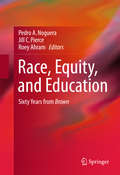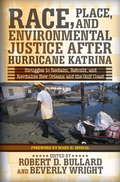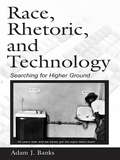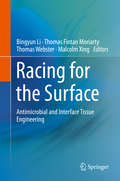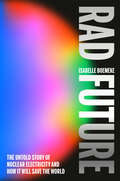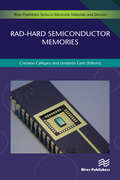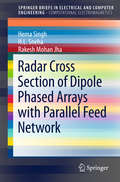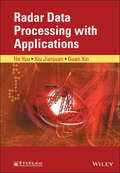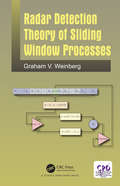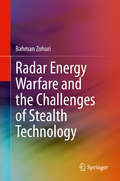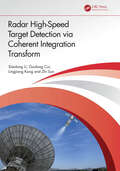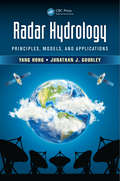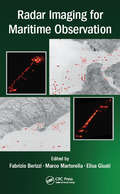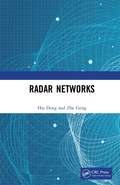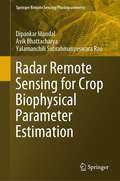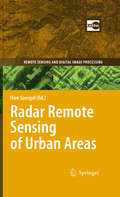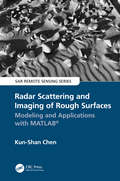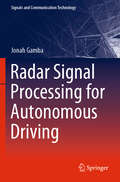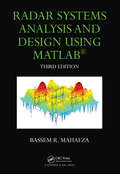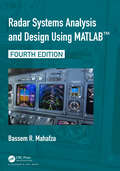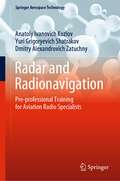- Table View
- List View
Race, Equity, and Education
by Pedro A. Noguera Jill C. Pierce Roey AhramThis powerful and timely analysis takes stock of race and education sixty years after the historic Brown vs. Board of Education decision. This volume examines education as one of the most visible markers for racial disparities in the US as well as one of its most visible frontiers for racial justice. Featuring original research, educators' insights, and perspectives from communities of color, it documents the complex impact of social/educational policy on social progress. Chapters on charter schools, curriculum content, performance measurement, and disproportionalities in special education referrals shed light on entrenched inequities that must be confronted. The book also makes it clear that leveling the playing field calls for not only better schools, but also addressing pervasive social problems such as poverty and housing segregation. Included in the coverage: School Policy is Housing Policy: Deconcentrating Disadvantage to Address the Achievement Gap. Charter Schooling, Race Politics, and an Appeal to History. The Data Quality Movement for the Asian American and Pacific Islander community: an unresolved civil rights issue. Critical Ethnic Studies in High School Classrooms: Academic Achievement via Social Action. Mexican American Educational Stagnation: The Role of Generational Status, Parental Narratives and Educator Mes sages. Pinpointing crucial issues and opportunities for solutions, Race, Equity, and Education has immediate salience for educators and researchers studying the intersection of race and education.
Race, Place, and Environmental Justice After Hurricane Katrina
by Robert BullardAnalyzing the immediate and long-term repercussions of Hurricane Katrina, the essays in this volume expose the racial disparities that exist in disaster response and recovery and challenge the geography of vulnerability
Race, Rhetoric, and Technology: Searching for Higher Ground
by Adam J. BanksIn this book Adam Banks uses the concept of the Digital Divide as a metonym for America's larger racial divide, in an attempt to figure out what meaningful access for African Americans to technologies and the larger American society can or should mean. He argues that African American rhetorical traditions--the traditions of struggle for justice and equitable participation in American society--exhibit complex and nuanced ways of understanding the difficulties inherent in the attempt to navigate through the seemingly impossible contradictions of gaining meaningful access to technological systems with the good they seem to make possible, and at the same time resisting the exploitative impulses that such systems always seem to present.Banks examines moments in these rhetorical traditions of appeals, warnings, demands, and debates to make explicit the connections between technological issues and African Americans' equal and just participation in American society. He shows that the big questions we must ask of our technologies are exactly the same questions leaders and lay people from Martin Luther King to Malcolm X to slave quilters to Critical Race Theorists to pseudonymous chatters across cyberspace have been asking all along. According to Banks the central ethical questions for the field of rhetoric and composition are technology access and the ability to address questions of race and racism. He uses this book to imagine what writing instruction, technology theory, literacy instruction, and rhetorical education can look like for all of us in a new century.Just as Race, Rhetoric, and Technology: Searching for Higher Ground is a call for a new orientation among those who study and profess African American rhetoric, it is also a call for those in the fields that make up mainstream English Studies to change their perspectives as well. This volume is intended for researchers, professionals, and students in Rhetoric and Composition, Technical Communication, the History of Science and Society, and African American Studies.
Race, Rigor, and Selectivity in U.S. Engineering: The History of an Occupational Color Line
by Amy Slaton<p>Despite the educational and professional advances made by minorities in recent decades, African Americans remain woefully underrepresented in the fields of science, technology, mathematics, and engineering. Even at its peak, in 2000, African American representation in engineering careers reached only 5.7 percent, while blacks made up 15 percent of the U.S. population. Some forty-five years after the Civil Rights Act sought to eliminate racial differences in education and employment, what do we make of an occupational pattern that perpetually follows the lines of race? <p>Race, Rigor, and Selectivity in U.S. Engineering pursues this question and its ramifications through historical case studies. Focusing on engineering programs in three settings—in Maryland, Illinois, and Texas, from the 1940s through the 1990s—Amy E. Slaton examines efforts to expand black opportunities in engineering as well as obstacles to those reforms. Her study reveals aspects of admissions criteria and curricular emphases that work against proportionate black involvement in many engineering programs. Slaton exposes the negative impact of conservative ideologies in engineering, and of specific institutional processes—ideas and practices that are as limiting for the field of engineering as they are for the goal of greater racial parity in the profession.</p>
Racing Ransom (The Gamer)
by Shawn PryorThe race is on for the Gamer! Villain Cynthia Cyber has captured two victims in her video game Space Racers. The helpless players cannot escape their speeding cars. Even worse, a monster racer is threatening to destroy them. The Gamer must drive on to the digital track and rescue the racers before it’s game over.
Racing for the Surface: Antimicrobial and Interface Tissue Engineering
by Bingyun Li Thomas Webster Thomas Fintan Moriarty Malcolm XingThis book covers the key basics of tissue engineering as well as the latest advances in the integration of both antimicrobial and osteoinductive properties. Topics covered include osteoconductive and osteoinductive biomaterials (calcium phosphate, bone morphogenetic protein, peptides, antibodies, bioactive glasses, nanomaterials, etc.) and scaffolds. Research integrating both antimicrobial/biofilm-inhibiting and osteoinductive/osteoconductive properties and their co-delivery is detailed and their roles in clinical success are discussed. Combined with its companion volume, Racing for the Surface: Antimicrobial and Interface Tissue Engineering, this book bridges the gap between infection and tissue engineering, and is an ideal book for academic researchers, clinicians, industrial engineers and scientists, governmental representatives in national laboratories, and advanced undergraduate students and post-doctoral fellows who are interested in tissue engineering and regeneration, infection, and biomaterials and devices.
Racing for the Surface: Pathogenesis of Implant Infection and Advanced Antimicrobial Strategies
by Bingyun Li Thomas Webster Thomas Fintan Moriarty Malcolm XingThis book covers the latest research in biofilm, infection, and antimicrobial strategies in reducing and treating musculoskeletal, skin, transfusion, implant-related infections, etc. Topics covered include biofilms, small colony variants, antimicrobial biomaterials (antibiotics, antimicrobial peptides, hydrogels, bioinspired interfaces, immunotherapeutic approaches, and more), antimicrobial coatings, engineering and 3D printing, antimicrobial delivery vehicles, and perspectives on clinical impacts. Antibiotic resistance, which shifts the race toward bacteria, and strategies to reduce antibiotic resistance, are also briefly touched on. Combined with its companion volume, Racing for the Surface: Pathogenesis of Implant Infection and Advanced Antimicrobial Strategies, this book bridges the gaps between infection and tissue engineering, and is an ideal book for academic researchers, clinicians, industrial engineers and scientists, governmental representatives in national laboratories, and advanced undergraduate students and post-doctoral fellows who are interested in infection, microbiology, and biomaterials and devices.
Rad Future: The Untold Story of Nuclear Electricity and How It Will Save the World
by Isabelle BoemekeWe&’re running out of time. Fossil fuels are choking the planet and renewable energy isn&’t cutting it. The solution has been hiding in plain sight all along.Nuclear.When most people hear that word, they go to a very bad place: bombs, Chernobyl, hazmat suits, radioactive fallout… the stuff of nightmares. But what if everything you think you know about nuclear is wrong?In Rad Future, science influencer Isabelle Boemeke shatters the fear and misinformation surrounding this technology and shows how the actual science tells a different story. It turns out that nuclear-generated electricity—nuclear electricity—is our best option for ensuring the future of the planet. Nuclear can power cities, desalinate water, create carbon-free fertilizer, and heat homes, all with the smallest environmental footprint of any energy source.Boemeke exposes how decades of fearmongering, a few dramatic (but preventable) disasters, and relentless bad PR have convinced the world that nuclear is dangerous when it&’s actually the key to an affordable, sustainable future. We&’ve fumbled the bag on the cleanest, most powerful energy source we have, and it&’s time to fix that.This isn&’t your typical science book. Boemeke&’s signature mix of humor, sass, and deep research makes Rad Future a wild ride through the science, history, and future of nuclear electricity. From Cold War politics to Hollywood-fueled paranoia to cutting-edge reactor designs, she details exactly how nuclear works and why it&’s our best shot at ending the climate crisis and creating a future of radical abundance. Rad Future is the first truly accessible breakdown of nuclear electricity, and it will leave you feeling stoked about what&’s possible.
Rad-hard Semiconductor Memories
by Cristiano Calligaro Umberto GattiRad-hard Semiconductor Memories is intended for researchers and professionals interested in understanding how to design and make a preliminary evaluation of rad-hard semiconductor memories, making leverage on standard CMOS manufacturing processes available from different silicon foundries and using different technology nodes.In the first part of the book, a preliminary overview of the effects of radiation in space, with a specific focus on memories, will be conducted to enable the reader to understand why specific design solutions are adopted to mitigate hard and soft errors. The second part will be devoted to RHBD (Radiation Hardening by Design) techniques for semiconductor components with a specific focus on memories. The approach will follow a top-down scheme starting from RHBD at architectural level (how to build a rad-hard floor-plan), at circuit level (how to mitigate radiation effects by handling transistors in the proper way) and at layout level (how to shape a layout to mitigate radiation effects).After the description of the mitigation techniques, the book enters in the core of the topic covering SRAMs (synchronous, asynchronous, single port and dual port) and PROMs (based on AntiFuse OTP technologies), describing how to design a rad-hard flash memory and fostering RHBD toward emerging memories like ReRAM. The last part will be a leap into emerging memories at a very early stage, not yet ready for industrial use in silicon but candidates to become an option for the next wave of rad-hard components. Technical topics discussed in the book include: Radiation effects on semiconductor components (TID, SEE) Radiation Hardening by Design (RHBD) Techniques Rad-hard SRAMs Rad-hard PROMs Rad-hard Flash NVMs Rad-hard ReRAMs Rad-hard emerging technologies
Radar Cross Section of Dipole Phased Arrays with Parallel Feed Network
by Hema Singh Rakesh Mohan Jha H. L. SnehaThis book presents the detailed analytical formulation for the RCS of parallel-fed linear dipole array in the presence of mutual coupling. The radar cross section (RCS) of an object represents its electromagnetic (EM) scattering properties for a given incident wave. The analysis of scattered field is critical in military and defence arenas, especially while designing low-observable platforms. It is well-known that the presence of an antenna/array on the target influences its echo area significantly. The primary cause for such scattering of the incident signals is reflection that occurs within the antenna aperture and its feed network. In this book, the RCS estimation is done based on the signal path within the antenna system. The scattered field is expressed in terms of array design parameters including the reflection and transmission coefficients. The computed results show the variation in the RCS pattern with and without mutual coupling. The effect of finite dipole-length, inter-element spacing, scan angle, array configuration, amplitude distribution and terminating load impedance on the RCS pattern is studied. It is shown that the array RCS can be controlled by choosing optimum design parameters, including terminating impedance and geometric configuration. This book explains each step of the RCS estimation and analysis of dipole array with detailed schematics, tables and illustrations. Moreover, it includes parametric analysis of RCS estimation and control. This book provides an insight into the phenomenon of scattering within the phased array system.
Radar Data Processing With Applications (Wiley - IEEE)
by He You Xiu Jianjuan Guan XinA systematic introduction to the theory, development and latest research results of radar data processing technology• Presents both classical theory and development methods of radar data processing• Provides state-of-the-art research results, including data processing for modern style radars, and tracking performance evaluation theory• Includes coverage of performance evaluation, registration algorithm for Radar network, data processing of passive radar, pulse Doppler radar, and phased array radar• Has applications for those engaged in information engineering, radar engineering, electronic countermeasures, infrared techniques, sonar techniques, and military command
Radar Detection Theory of Sliding Window Processes
by Graham WeinbergConstant false alarm rate detection processes are important in radar signal processing. Such detection strategies are used as an alternative to optimal Neyman-Pearson based decision rules, since they can be implemented as a sliding window process running on a radar range-Doppler map. This book examines the development of such detectors in a modern framework. With a particular focus on high resolution X-band maritime surveillance radar, recent approaches are outlined and examined. Performance is assessed when the detectors are run in real X-band radar clutter. The book introduces relevant mathematical tools to allow the reader to understand the development, and follow its implementation.
Radar Energy Warfare and the Challenges of Stealth Technology
by Bahman ZohuriThis book provides a solid foundation for understanding radar energy warfare and stealth technology. The book covers the fundamentals of radar before moving on to more advanced topics, including electronic counter and electronic counter-counter measures, radar absorbing materials, radar cross section, and the science of stealth technology. A final section provides an introduction to Luneberg lens reflectors. The book will provide scientists, engineers, and students with valuable guidance on the fundamentals needed to understand state-of-the-art radar energy warfare and stealth technology research and applications.
Radar High-Speed Target Detection via Coherent Integration Transform
by Xiaolong Li Guolong Cui Lingjiang Kong Zhi SunRadar High-Speed Target Detection via Coherent Integration Transform offers a systematic presentation of high-speed radar target detection methods using coherent integration transforms including the signal model, derivations of coherent integration transforms, and definitions of related key concepts.The authors present mathematical models and design principles necessary to analyze the behavior of each type of coherent integration transform, and based on this, they introduce and convey new approaches and techniques for designing such transforms, which will help to achieve efficient signal integrators and detectors, especially in the challenging low signal-to-noise ratio (SNR) environments.The book will be of interest to graduate students and engineering professionals in statistical signal processing, signal detection and estimation, and radar signal processing.
Radar Hydrology: Principles, Models, and Applications
by Yang Hong Jonathan J. GourleyRadar Hydrology: Principles, Models, and Applications provides graduate students, operational forecasters, and researchers with a theoretical framework and practical knowledge of radar precipitation estimation. The only text on the market solely devoted to radar hydrology, this comprehensive reference: Begins with a brief introduction to radar Focuses on the processing of radar data to arrive at accurate estimates of rainfall Addresses advanced radar sensing principles and applications Covers radar technologies for observing each component of the hydrologic cycle Examines state-of-the-art hydrologic models and their inputs, parameters, state variables, calibration procedures, and outputs Discusses contemporary approaches in data assimilation Concludes with methods, case studies, and prediction system design Includes downloadable MATLAB® content Flooding is the #1 weather-related natural disaster worldwide. Radar Hydrology: Principles, Models, and Applications aids in understanding the physical systems and detection tools, as well as designing prediction systems.
Radar Imaging for Maritime Observation (Signal and Image Processing of Earth Observations)
by Fabrizio Berizzi Marco Martorella Elisa GiustiBased on the experiences of the Department of Information Engineering of the University of Pisa and the Radar and Surveillance System (RaSS) national laboratory of the National Interuniversity Consortium of Telecommunication (CNIT), Radar Imaging for Maritime Observation presents the most recent results in radar imaging for maritime observation. The book explores both the areas of sea surface remote sensing and maritime surveillance providing key theoretical concepts of SAR and ISAR imaging and more advanced and ad-hoc techniques for applications in maritime scenarios. The book is organized in two sections. The first section discusses the fundamentals of standard SAR/ISAR processing and novel imaging techniques, such as Bistatic, Passive, and, 3D Interferometric ISAR. The second section focuses on the applications and results obtained by processing real data from maritime observations like SAR image processing for oil spill, detection in SAR images and fractal analysis. Useful to both beginners and experts in maritime observation, this book provides several examples of (mainly space-borne) radar imaging of maritime targets. Nevertheless, the same principles and techniques apply to the case of manned or unmanned carriers and to ground and air moving targets.
Radar Networks
by Hai DengRadar networks are increasingly regarded as an efficient approach to enhancing radar capabilities in the face of popular anti-radar techniques and hostile operating environments. Reader-friendly and self-contained, this book provides a comprehensive overview of the latest radar networking technologies. The text addresses basic, relevant aspects of radar signal processing and statistical theories, including both civilian and military radar applications. It also discusses emerging topics that directly relate to networks, such as multiple-input–multiple-output (MIMO) radars, waveform design, and diversity via multiple transmitters. Other topics covered include target recognition and imaging using radar networks. Features Gives a comprehensive view of the latest radar network technologies Covers both civilian and military applications of radar Provides basic statistics and signal processing necessary for understanding radar networks Includes up-to-date information on MIMO radars Presents waveform design and diversity for radar networks with multiple transmitters
Radar Remote Sensing for Crop Biophysical Parameter Estimation (Springer Remote Sensing/Photogrammetry)
by Dipankar Mandal Avik Bhattacharya Yalamanchili Subrahmanyeswara RaoThis book presents a timely investigation of radar remote sensing observations for agricultural crop monitoring and advancements of research techniques and their applicability for crop biophysical parameter estimation. It introduces theoretical background of radar scattering from vegetation volume and semi-empirical modelling approaches that are the foundation for biophysical parameter inversion. The contents will help readers explore the state-of-the-art crop monitoring and biophysical parameter estimation using approaches radar remote sensing. It is useful guide for academicians, practitioners and policymakers.
Radar Remote Sensing of Urban Areas
by Uwe SoergelThis book presents a unique collection of state-of-the-art contributions by international remote sensing experts focussing on methodologies to extract information about urban areas from Synthetic Aperture Radar (SAR) data. SAR is an active remote sensing technique capable to gather data independently from sun light and weather conditions. Emphasizing technical and geometrical issues the potential and limits of SAR are addressed in focussed case studies, for example, the detection of buildings and roads, traffic monitoring, surface deformation monitoring, and urban change. These studies can be sorted into two groups: the mapping of the current urban state and the monitoring of change. The former covers, for instance, methodologies for the detection and reconstruction of individual buildings and road networks; the latter, for example, surface deformation monitoring and urban change. This includes also investigations related to the benefit of SAR Interferometry, which is useful to determine either digital elevation models and surface deformation or the radial velocity of objects (e.g. cars), and the Polarization of the signal that comprises valuable information about the type of soil and object geometry. Furthermore, the features of modern satellite and airborne sensor devices which provide high-spatial resolution of the urban scene are discussed.
Radar Scattering and Imaging of Rough Surfaces: Modeling and Applications with MATLAB® (SAR Remote Sensing)
by Kun-Shan ChenRadar scattering and imaging of rough surfaces is an active interdisciplinary area of research with many practical applications in fields such as mineral and resource exploration, ocean and physical oceanography, military and national defense, planetary exploration, city planning and land use, environmental science, and many more. By focusing on the most advanced analytical and numerical modeling and describing both forward and inverse modeling, Radar Scattering and Imaging of Rough Surfaces: Modeling and Applications with MATLAB® connects the scattering process to imaging techniques by vivid examples through numerical and experimental demonstrations and provides computer codes and practical uses. This book is unique in its simultaneous treatment of radar scattering and imaging. Key Features Bridges physical modeling with simulation for resolving radar imaging problems (the first comprehensive work to do so) Provides excellent basic and advanced information for microwave remote-sensing professionals in various fields of science and engineering Covers most advanced analytical and numerical modeling for both backscattering and bistatic scattering Includes MATLAB® codes useful not only for academics but also for radar engineers and scientists to develop tools applicable in different areas of earth studies Covering both the theoretical and the practical, Radar Scattering and Imaging of Rough Surfaces: Modeling and Applications with MATLAB® is an invaluable resource for professionals and students using remote sensing to study and explain the Earth and its processes. University and research institutes, electrical and radar engineers, remote-sensing image users, application software developers, students, and academics alike will benefit from this book. The author, Kun-Shan Chen, is an internationally known and respected engineer and scientist and an expert in the field of electromagnetic modeling.
Radar Signal Analysis and Processing Using MATLAB
by Bassem R. MahafzaOffering radar-related software for the analysis and design of radar waveform and signal processing, Radar Signal Analysis and Processing Using MATLAB provides a comprehensive source of theoretical and practical information on radar signals, signal analysis, and radar signal processing with companion MATLAB code.Aft
Radar Signal Processing for Autonomous Driving (Signals and Communication Technology)
by Jonah GambaThe subject of this book is theory, principles and methods used in radar algorithm development with a special focus on automotive radar signal processing. In the automotive industry, autonomous driving is currently a hot topic that leads to numerous applications for both safety and driving comfort. It is estimated that full autonomous driving will be realized in the next twenty to thirty years and one of the enabling technologies is radar sensing. This book presents both detection and tracking topics specifically for automotive radar processing. It provides illustrations, figures and tables for the reader to quickly grasp the concepts and start working on practical solutions. The complete and comprehensive coverage of the topic provides both professionals and newcomers with all the essential methods and tools required to successfully implement and evaluate automotive radar processing algorithms.
Radar Systems Analysis and Design Using MATLAB
by Bassem R. MahafzaDeveloped from the author's graduate-level courses, the first edition of this book filled the need for a comprehensive, self-contained, and hands-on treatment of radar systems analysis and design. It quickly became a bestseller and was widely adopted by many professors. The second edition built on this successful format by rearranging and updating
Radar Systems Analysis and Design Using MATLAB
by Bassem R. MahafzaThe first edition of this ground-breaking and widely used book introduced a comprehensive textbook on radar systems analysis and design providing hands-on experience facilitated by its companion MATLAB® software. The book very quickly turned into a bestseller. Based on feedback provided by several users and drawing from the author's own teaching experience, the 4th edition adopts a new approach. The presentation in this edition takes the reader on a scientific journey whose major landmarks comprise the different radar sub-systems and components. Along the way, the different relevant radar subsystems are analyzed and discussed in great level of detail. Understanding the radar signal types and their associated radar signal processing techniques are key to understating how radar systems function. Each chapter provides the necessary mathematical and analytical coverage required for a sound understanding of radar theory. Additionally, dedicated MATLAB® functions/programs enhance the understanding of the theory and establish a means to perform radar system analysis and design trades. The software provides users with numerous varieties of graphical outputs. Additionally, a complete set of MATLAB® code that generates all plot and graphs found within the pages of this textbook are also available. All companion MATLAB® code can be downloaded from the book’s web page. The 4th Edition: •Takes advantage of the new features offered by MATLAB® 2021 release•Brings the text to a current state of the art•Incorporates much of the feedback received from users using this book as a text and from practicing engineers; accordingly, several chapters have been rewritten•Presents unique topics not found in other books•Maintains a comprehensive and exhaustive presentation•Restructures the presentation to be more convenient for course use.•Provides a post-course reference for engineering students as they enter the field•Offers a companion solutions manual for instructors The 4th edition will serve as a valuable tool to students and radar engineers by helping them better analyze and understand the many topics of radar systems. This book is written primarily as a graduate-level textbook, although parts of it can be used as a senior level course. A companion solutions manual has been developed for use by instructors.
Radar and Radionavigation: Pre-professional Training for Aviation Radio Specialists (Springer Aerospace Technology)
by Dmitry Alexandrovich Zatuchny Anatoly Ivanovich Kozlov Yuri Grigoryevich ShatrakovThis book highlights the capabilities and limitations of radar and air navigation. It discusses issues related to the physical principles of an electromagnetic field, the structure of radar information, and ways to transmit it. Attention is paid to the classification of radio waves used for transmitting radar information, as well as to the physical description of their propagation media. The third part of the book addresses issues related to the current state of navigation systems used in civil aviation and the prospects for their development in the future, as well as the history of satellite radio navigation systems. The book may be useful for schoolchildren, interested in the problems of radar and air navigation.
